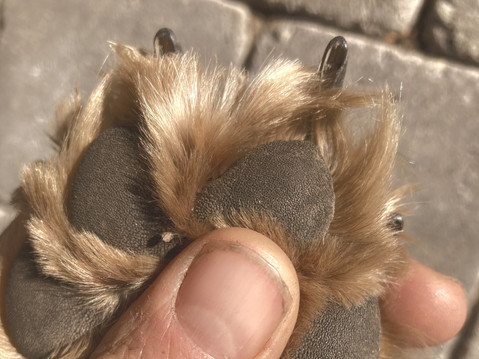Loving your dog, head to nails - Buddy Wellness 🌿
- Team Alaska
- Oct 27, 2021
- 4 min read
Updated: Sep 22, 2023
A Guide to Healthy Dog Nails
Why do dogs need their nails trimmed?
Dogs love running around, playing fetch, playing with other dogs, scrambling on rocks - all the things Buddy dogs love to do on their outings. If the dogs were spending most of their time out on cement or pavement, your dog’s nails would likely wear down on their own. Playing in the dirt and snow usually doesn’t do the trick, so Tahoe dogs run the risk of their nails growing too long and potentially cracking or breaking while they are being active and having fun. When a dog breaks or cracks a nail it can expose or injure the quick (the nerve and blood-rich tissue in the center of each nail), the sensitivity is akin to humans having a cracked and torn cuticle. This can be extremely painful for the dog and may require a visit to the veterinarian before they can resume their regular activities. Awareness and prevention (with regular nail trims) is the best medicine!

Maintaining the proper length of their nails is an important part of caring for a dog. If a dog’s nails are allowed to grow too long, the tips of the nails press into the ground (or hard floors, pavement, rocks, etc.), and in turn that pressure is passed into the dog’s nail bed and toes. Think of how it might feel when you wear too tight shoes all day - not comfortable at all. This is similar for a dog when their nails press against the ground.
In addition, nails that are too long may cause a dog to shift its bodyweight back on their footpads and adjust their gait when they move, putting them out of normal alignment. Over the long term, this may cause compensating injuries throughout their body.
If a dog’s nails are not trimmed regularly the “quick” will grow longer into the nail tip. This makes it riskier for the quick to get cut during the dog’s next nail trim which can be painful for the dog. Regular nail trims help to keep the quick further back in the nail, reducing the risk of it getting cut during a trim.
Many people mistakenly think that longer nails will give their dogs better grip or traction on slippery surfaces, but the opposite is true. Most of a dog’s traction comes from their toe and paw pads. The skin there is textured and rough and helps them grip a variety of surfaces. If nails are too long they will keep a large portion of the toe pads from touching the ground and actually reduce the traction for the dog.
How often do they need to be trimmed?
Each dog’s nails are different, just like human fingers and toenails. Some grow very long very quickly, some are very brittle and dry, some are thick and dense, some dogs chew their own nails down, etc. so there is no hard and fast rule. However, a general rule of thumb is to trim about every 4 weeks for maintenance.
In summer you may find your dog wears their nails down faster by running around on more paved and other rough surfaces. This means they may need trims less frequently (maybe every 6 weeks or so). However, if your dog spends a lot of time on soft dirt, grass, swimming, etc. they are likely not grinding their nails shorter even in summer and will still need regular trims.
In winter, when soft snow (hopefully) covers the ground, it does nothing to help wear dog nails down. Couple that with drier, colder air outdoors and hot, dry air inside our heated homes, and dog paws and nails can get quite dried out and brittle (just like our skin and nails in winter). The risk of breaking a nail is greater. Likely your dog will need more frequent nail trims in the winter months.
How can I tell if my dog needs a trim?
If you can hear your dog's nails clicking on your floors or on the pavement they are ready for a trim.
If you look at your dog when they are standing on a flat, level, hard surface and their nails are all touching the ground, they are ready for a trim. The proper length for dog nails is when they don’t quite touch the ground when the dog stands naturally. This ensures that their toe pads are bearing their weight and providing maximum traction.
If you lift your dog’s paw up and look at the underside of the nail it should be flat. If you can see a curved tip or hollow edges on the nail with a sunken center, your dog is ready for a trim.
How can Buddy help?
At Buddy, our goal is to help ensure your dogs are happy, healthy, and ready to run and play with their buddies every week. If we see a dog with obviously long nails, we will try to let you know. We encourage you to learn or ask how to do nail trims yourself for your dog. If you would like us to try to do it for you, Buddy does offer nail trim services. If you sign up for nail trim services, we will check your dog’s nails about every 4 weeks and if they are in need of trimming, we will check with you to see if you want them trimmed. If you'd like to sign up for this, simply email office@buddydogcare.com and let us know!
Unfortunately, we can’t trim every dog’s nails after outings, especially dogs that react to having their paws handled. Some dogs need a little more assistance to feel comfortable with the nail trim process. Lilith can offer desensitization training if your dog is too reactive to having their nails trimmed easily at home or after Buddy outings and needs some additional training or help.
If you want some advice and a hands-on demonstration of how to trim your own dog’s nails at home, we are always happy to show you the tools and techniques we use to trim nails. We want your dog to be relaxed and happy and enjoy nail trims whether it’s with you or with us.












Comments